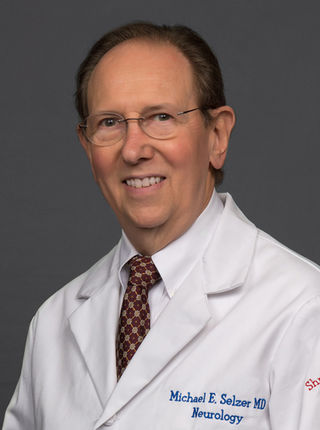Michael E. Selzer, MD, PhD
Professor, Neural Sciences
Professor, Shriners Hospitals Pediatric Research Center

- Contact Information
-
Contact Information
Phone
215-926-9318 - About Me
-
Clinical Interests
- Neurorehabilitation
Research Interests
Dr. Selzer’s research is in the area of regeneration in the central nervous system, using the spinal cord of the sea lamprey as a model for determining the molecular mechanisms that underlie regrowth of axons after injury. Early on, his laboratory demonstrated that spinal cord axons regenerate selectively in their correct paths and make physiologically functioning synapses specifically with correct neuron types. The spinal-projecting neurons in the brainstem are very heterogeneous in their regenerative abilities. Those that are bad regenerators downregulate neurofilament (NF) mRNA expression permanently after axon section, whereas good regenerators show recovery of NF expression. Since the regenerating axon tips lack filopodia, have sparse F-actin and are densely packed with NFs, the Selzer lab is testing whether NFs are involved in the mechanism of regeneration. They are now using in vivo micro-imaging and two-photon microscopy to distinguish axons that are actively regenerating from those that are static or retracting and observe their responses to pharmacological and molecular manipulations. Using these microimaging techniques, they have found that axon regeneration is intermittent and that increasing cAMP activity increases the velocity of axon regeneration but not the time spent in forward movement, as opposed to stasis or retraction. Another characteristic of bad regenerating neurons is their upregulation of receptors for certain guidance molecules after axotomy. In other systems, these receptors act as “dependence receptors,” activating an apoptosis cascade when they are not bound by their ligand. With Dr. Michael Shifman, Dr. Selzer has found that the ligands for these receptors are down-regulated transiently near the site of spinal cord transection, and that the bad-regenerating neurons undergo delayed apoptotic cell death, i.e., they are TUNEL and caspase 3 positive and eventually disappear. Thus, the lab is now testing whether certain neurons are bad regenerators because at the time of assessment, they are already undergoing very slow dependence receptor-mediated apoptosis.
Dr. Selzer is the recipient of numerous grants and awards from the NIH and other government and voluntary organizations and has served on peer review panels for the NIH, the Department of Veterans Affairs and the National Multiple Sclerosis Society.
- Education, Training & Credentials
-
Educational Background
- Residency, Hospital of the University of Pennsylvania, Philadelphia, PA, 1974
- Fellowship, Clinical Associate, National Institute of Neurological Disorders and Stroke (NINDS), National Institutes of Health, Bethesda, MD, 1971
- Internship, New York University, Bellview Hospital, New York, NY, 1969
- MD/PhD, New York University, New York, NY, 1968
- A.B. Degree, University of Pennsylvania, Philadelphia, PA, 1962
Certifications
- Psychiatry and Neurology
Memberships
- Fellow, American Academy of Neurology
- President, World Federation for Neurorehabilitation (WFNR)
- American Neurological Association
- American Society of Neurorehabilitation
- Philadelphia College of Physicians
- Philadelphia Neurological Society
- Publications
-
Digital Bibliography
